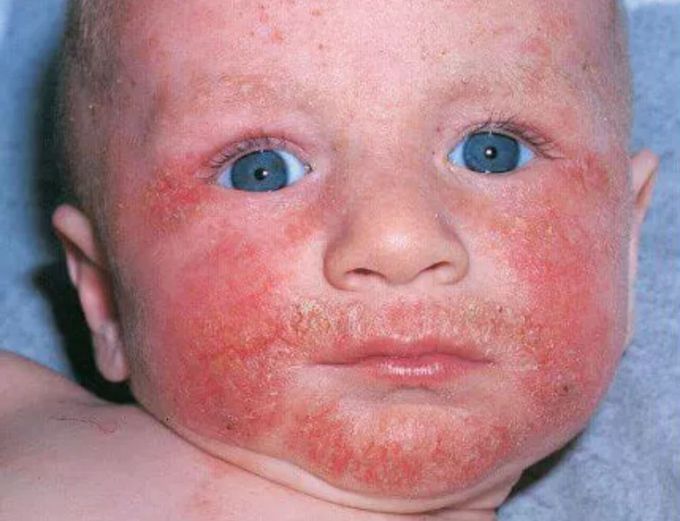


ATOPIC DERMATITIS
Atopic dermatitis is a chronic eczematous skin disease that usually begins in childhood. A predisposition to atopic dermatitis is inherited. Patients with atopic dermatitis have "super sensitive" skin and a decreased threshold for irritation. Acute atopic dermatitis produces weeping, oozing plaques of very itchy skin. Itching is a characteristic symptom. Chronic atopic dermatitis appears as thickened, elevated plaques of scaling skin. Patients with atopic dermatitis seem to have a misguided immune response. Treatment of atopic dermatitis is centered around rehydrating the skin with emollients like petroleum jelly and the cautious use of topical steroids to reduce inflammation and itching. Oral antihistamines may be helpful in breaking the "itch-scratch" cycle. Since secondary infections can aggravate the rash, oral antibiotics may also be occasionally indicated. Atopic dermatitis is a common, often persistent skin disease that affects a large percentage of the world's population. Atopy is a special type of allergic hypersensitivity that is associated with asthma, inhalant allergies (hay fever), and chronic dermatitis. There is a known hereditary component of the disease, and it is more common in affected families. Criteria that enable a doctor to diagnose it include the typical appearance and distribution of the rash in a patient with a personal or family history of asthma and/or hay fever. The term atopic is from the Greek meaning "strange." The term dermatitis means inflammation of the skin. Many physicians and patients use the term eczema when they are referring to this condition. Sometimes it is called neurodermatitis. In atopic dermatitis, the skin becomes extremely itchy and inflamed, causing redness, swelling, vesicle formation (minute blisters), cracking, weeping, crusting, and scaling. This type of eruption is termed eczematous. In addition, dry skin is a very common complaint in almost all those afflicted with atopic dermatitis. Although atopic dermatitis can occur at any age, most often it affects infants and young children. Occasionally, it may persist into adulthood or may rarely appear at that time. Some patients tend to have a protracted course with ups and downs. In most cases, there are periods of time when the disease is worse, called exacerbations or flares, which are followed by periods when the skin improves or clears up entirely, called remissions. Many children with atopic dermatitis enter into a permanent remission of the disease when they get older, although their skin may remain somewhat dry and easily irritated. Multiple factors can trigger or worsen atopic dermatitis, including low humidity, seasonal allergies, exposure to harsh soaps and detergents, and cold weather. Environmental factors can activate symptoms of atopic dermatitis at any time in the lives of individuals who have inherited the atopic disease trait. How common is atopic dermatitis? Atopic dermatitis is very common worldwide and increasing in prevalence. It affects males and females equally and accounts for 10%-20% of all referrals to dermatologists (doctors who specialize in the care and treatment of skin diseases). Atopic dermatitis occurs most often in infants and children, and its onset decreases substantially with age. Of those affected, 65% of patients develop symptoms in the first year of life, and 90% develop symptoms before the age of 5. Onset after age 30 is uncommon and often occurs after exposure of the skin to harsh conditions. People who live in urban areas and in climates with low humidity seem to be at an increased risk for developing atopic dermatitis. About 10% of all infants and young children experience symptoms of the disease. Roughly 60% of these infants continue to have one or more symptoms of atopic dermatitis even after they reach adulthood. This means that more than 15 million people in the United States have symptoms of the disease. What are the symptoms and signs of atopic dermatitis? Although symptoms and signs may vary from person to person, the most common symptoms are dry, itchy, red skin. Itch is the hallmark of the disease. Typically, affected skin areas include the folds of the arms, the back of the knees, wrists, face, and neck. The itchiness is an important factor in atopic dermatitis, because scratching and rubbing can worsen the skin inflammation that is characteristic of this disease. People with atopic dermatitis seem to be more sensitive to itching and feel the need to scratch longer in response. They develop what is referred to as the "itch-scratch" cycle. The extreme itchiness of the skin causes the person to scratch, which in turn worsens the itch, and so on. Itching is particularly a problem during sleep, when conscious control of scratching decreases and the absence of other outside stimuli makes the itchiness more noticeable. What are the causes and risk factors of atopic dermatitis? The cause of atopic dermatitis is not known, but the disease seems to result from a combination of genetic (hereditary) and environmental factors. There seems to be a basic cutaneous hypersensitivity and an increased tendency toward itching. Evidence suggests that the disease is associated with other so-called atopic disorders such as hay fever (seasonal allergies) and asthma, which many people with atopic dermatitis also have. In addition, many children who outgrow the symptoms of atopic dermatitis go on to develop hay fever or asthma. Although one disorder does not necessarily cause another, they may be related, thereby giving researchers clues to understanding atopic dermatitis. Many of those affected seem to have either a decreased quantity of or a defective form of a protein called filaggrin in their skin. This protein seem to be important in maintaining normal cutaneous hydration. It is important to understand that food sensitivities do not seem to be a major inciting factor for most cases of atopic dermatitis. This is an area of active research. Patients with atopic dermatitis seem to have mild immune system weakness. They are predisposed to develop fungal foot disease and cutaneous staphylococcal infections, and they can disseminate herpes simplex lip infections (eczema herpeticum) and smallpox vaccination (eczema vaccinatum) to large areas of skin. While emotional factors and stress may sometimes exacerbate the condition, they do not seem to be a primary or underlying cause for the disorder. Can atopic dermatitis affect the face? Yes. Atopic dermatitis may affect the skin around the eyes, the eyelids, the eyebrows, and lashes. Scratching and rubbing the eye area can cause the skin to change in appearance. Some people with atopic dermatitis develop an extra fold of skin under their eyes, called an atopic pleat or Dennie-Morgan fold. Other people may have hyperpigmented eyelids, meaning that the skin on their eyelids darkens from the inflammation or hay fever (allergic shiners). Patchy eyebrows and eyelashes may also result from scratching or rubbing. The face is very commonly affected in babies, who may drool excessively, and become irritated from skin contact with their abundant saliva. The skin of a person with atopic dermatitis loses excessive moisture from the epidermal layer. Some patients with atopic dermatitis lack a protein called filaggrin that is important in retaining moisture. This defective genetic trait allows the skin to become very dry, which reduces its protective abilities. In addition, the skin is very susceptible to infectious disorders, such as staphylococcal and streptococcal bacterial skin infections, warts, herpes simplex, and molluscum contagiosum (which is caused by a virus). Skin features of atopic dermatitis Lichenification: thick, leathery skin resulting from constant scratching and rubbing Lichen simplex: refers to a thickened patch of raised skin that results from repeat rubbing and scratching of the same skin area Papules: small, raised bumps that may open when scratched, becoming crusty and infected Ichthyosis: dry, rectangular scales on the skin, commonly on the lower legs and shins Keratosis pilaris: small, rough bumps, generally on the face, upper arms, and thighs. These are also described as gooseflesh or chicken skin and may have a small coiled hair under each bump. Hyper-linear palms: increased number of skin creases on the palms Urticaria: hives (red, raised bumps), often after exposure to an allergen, at the beginning of flare-ups, or after exercise or a hot bath Cheilitis: inflammation of the skin on and around the lips Atopic pleat (Dennie-Morgan fold): an extra fold of skin that develops under the eye Dark circles under the eyes: may result from allergies and atopy Hyperpigmented eyelids: scaling eyelids that have become darker in color from inflammation or hay fever Prurigo nodules also called "picker's warts" are not really warts at all. These are small thickened bumps of the skin caused by repeated picking of the same skin site. Is atopic dermatitis contagious? No. Atopic dermatitis itself is definitely not contagious, and it cannot be passed from one person to another through skin contact. There is generally no cause for concern in being around someone with even an active case of atopic dermatitis, unless they have active skin infections. Some patients with atopic dermatitis get secondary infections of their skin with Staphylococcus ("staph"), other bacteria, herpes virus (cold sores), and less commonly yeasts and other fungal infections. These infections may be contagious through skin contact.
i actually have this disease and i did not know all of this about it, thanks for the information!


